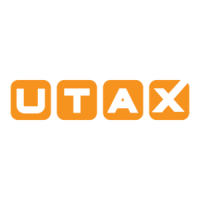
Do you have a question about the Utax cd 1120 and is the answer not in the manual?
| Functions | Print, Copy, Scan |
|---|---|
| Connectivity | USB 2.0 |
| Scanner Type | Flatbed |
| Automatic Document Feeder | No |
| Display | LCD |
| First page out time | 8.5 seconds |
| Output Capacity | 100 sheets |
| Memory | 32 MB |
| Duplex Printing | Manual |
| Copy Resolution | 600 x 600 dpi |
| Printing Technology | Laser |
| Print Speed (Black) | 20 ppm |
| Copy Speed (Black) | 20 cpm |
| Paper Size | A4 |
| Operating System Compatibility | Windows |
Defines DANGER, WARNING, CAUTION, and symbols for hazard communication.
Outlines warnings for power supply, grounding, placement, and environment.
Emphasizes safety during disassembly, use of correct parts, and following procedures.
Details product type, copying system, paper handling, sizes, and speeds.
Identifies major external components and operation panel layout.
Illustrates the internal arrangement of the machine's functional units.
Details the gears and motors within the drive system.
Provides specific guidelines for handling and storing the drum unit safely.
Offers recommendations for storing toner cartridges correctly.
Specifies optimal temperature, humidity, power, and location conditions.
Outlines the general steps for unpacking and performing the initial installation.
Configures default copy settings like counts, toner detection, and display order.
Details the process for installing an optional paper feeder unit.
Details the process for installing an optional document processor.
Details the process for installing an optional duplex unit.
Details the process for installing an optional drawer heater.
Details the process for installing an optional key counter.
Details the process for installing an optional finisher.
Details the process for installing an optional job separator.
Details the process for installing an optional fax system.
Details the process for installing an optional scan system.
Details the process for installing an optional hard disk.
Describes how to access and run specific maintenance functions.
Provides a detailed list of all maintenance modes, their functions, and initial settings.
Explains how users can access and utilize the machine's management features.
Configures default exposure, quality, and paper selection for copying.
Sets default paper size, type, orientation, and sleep/clear functions.
Configures bypass tray paper size and type settings.
Checks total counts and prints counter reports.
Prints various status reports such as copy, machine, and coverage reports.
Switches the operation panel language displayed on the machine.
Identifies paper misfeed locations and the conditions that trigger detection.
Describes system errors and partial operation control codes.
Lists common image quality issues, their causes, and corrective measures.
Diagnoses issues related to power, motors, and PCB failures.
Addresses problems with paper feeding, alignment, and component operation.
Provides critical safety guidelines and handling advice before starting disassembly.
Details procedures for replacing pulleys, rollers, and conveying units.
Covers replacement of the exposure lamp and scanner wires.
Details procedures for replacing the drum unit and separation claws.
Provides the procedure for replacing the developing unit.
Details the steps for replacing the transfer roller.
Covers replacement of the fixing unit, press roller, and heaters.
Details how to adjust the fixing unit height to correct image skew.
Outlines the steps for upgrading the firmware on the main PCB using Compact Flash.
Details the process for upgrading the printer board firmware using Compact Flash.
Lists variable resistors that are factory-set and not field-adjustable.
Provides notes on firmware versions and EEPROM handling during PCB replacement.
Explains how paper is conveyed from drawers and bypass to registration rollers.
Describes the components involved in scanning and laser printing.
Details the components related to the drum, charging, and cleaning.
Explains the developing unit, toner container, and magnetic brush formation.
Covers the transfer roller, separation electrode, and drum separation claws.
Details the components responsible for fusing toner onto paper.
Explains how paper exits the machine and is reversed for duplex copying.
Describes the mechanism for reversing paper for duplex copying.
Lists and describes the main PCBs and their functions within the machine.
Identifies various switches and sensors and their roles in machine operation.
Lists the motors and their corresponding driven sections or functions.
Identifies other electrical components like clutches, heaters, and lamps.
Illustrates the power supply circuit and its components.
Shows the major components and interconnections of the main control board.
Illustrates the components and connections on the engine control board.
Shows the block diagram of the operation unit PCB.
Shows the block diagram of the CCD PCB.
Illustrates paper feed timing from the drawer for specific paper sizes.
Details paper feed timing from the drawer for larger paper sizes.
Details paper feed timing from the first paper feeder.
Details paper feed timing from the second paper feeder.
Summarizes procedures for adjusting image magnification and margins.
Outlines routine cleaning and replacement schedules for machine parts.
Provides detailed cleaning and replacement instructions by section.